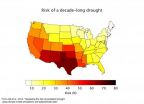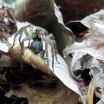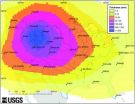(Press-News.org) ROSEMONT, Ill.—Being physically active may significantly improve musculoskeletal and overall health, and minimize or delay the effects of aging, according to a review of the latest research on senior athletes (ages 65 and up) appearing in the September issue of the Journal of the American Academy of Orthopaedic Surgeons (JAAOS).
It long has been assumed that aging causes an inevitable deterioration of the body and its ability to function, as well as increased rates of related injuries such as sprains, strains and fractures; diseases, such as obesity and diabetes; and osteoarthritis and other bone and joint conditions. However, recent research on senior, elite athletes suggests usage of comprehensive fitness and nutrition routines helps minimize bone and joint health decline and maintain overall physical health.
"An increasing amount of evidence demonstrates that we can modulate age-related decline in the musculoskeletal system," said lead study author and orthopaedic surgeon Bryan G. Vopat, MD. "A lot of the deterioration we see with aging can be attributed to a more sedentary lifestyle instead of aging itself."
The positive effects of physical activity on maintaining bone density, muscle mass, ligament and tendon function, and cartilage volume are keys to optimal physical function and health. In addition, the literature recommends a combined physical activity regimen for all adults encompassing resistance, endurance, flexibility and balance training, "as safely allowable for a given person." Among the recommendations:
Resistance training. Prolonged, intense resistance training can increase muscle strength, lean muscle and bone mass more consistently than aerobic exercise alone. Moderately intense resistance regimens also decrease fat mass. Sustained lower and upper body resistance training bolsters bone density and reduces the risk of strains, sprains and acute fractures.
Endurance training. Sustained and at least moderately intensive aerobic training promotes heart health, increases oxygen consumption, and has been linked to other musculoskeletal benefits, including less accumulation of fat mass, maintenance of muscle strength and cartilage volumes. A minimum of 150 to 300 minutes a week of endurance training, in 10 to 30 minute episodes, for elite senior athletes is recommended. Less vigorous and/or short-duration aerobic regimens may provide limited benefit.
Flexibility and balance. Flexibility exercises are strongly recommended for active older adults to maintain range of motion, optimize performance and limit injury. Two days a week or more of flexibility training—sustained stretches and static/non-ballistic (non-resistant) movements—are recommended for senior athletes. Progressively difficult postures (depending on tolerance and ability) are recommended for improving and maintaining balance.
The study also recommends "proper" nutrition for older, active adults to optimize performance. For senior athletes, a daily protein intake of 1.0 to 1.5 g/kg is recommended, as well as carbohydrate consumption of 6 to 8 g/kg (more than 8 g/kg in the days leading up to an endurance event).
"Regimens must be individualized for older adults according to their baseline level of conditioning and disability, and be instituted gradually and safely, particularly for elderly and poorly conditioned adults," said Dr. Vopat. According to study authors, to improve fitness levels and minimize bone and joint health decline, when safely allowable, patients should be encouraged to continually exceed the minimum exercise recommendations.
INFORMATION:
September 2014 Full JAAOS Table of Contents
ACGME Duty Hour Requirements: Perceptions and Impact on Resident Training and Patient Care
Os Trigonum Syndrome
Etiology, Diagnosis, and Management of Failed SLAP Repair
Controversies in the Management of Distal Radius Fractures
The Effects of Fitness on the Aging Process
Malignant Transformation in Chronic Osteomyelitis: Recognition and Principles of Management
Direct Anterior Approach for Total Hip Arthroplasty: Indications, Technique, and Results
For more AAOS news, visit the News Bureau
Follow AAOS on Twitter
Follow AAOS on Facebook
Google+
Orthopaedic surgeons restore mobility and reduce pain; they help people get back to work and to independent, productive lives. Visit ANationInMotion.org to read successful orthopaedic stories.
More information about the AAOS
Disclosures
From the Department of Orthopaedics, Warren Alpert Medical School of Brown University, Rhode Island Hospital, Providence, RI. (Bryan G. Vopat, MD, Stephen A. Klinge, MD; Philip K. McClure, MD; Paul D. Fadale, MD).
Dr. Fadale or an immediate family member has received research or institutional support from Arthrex, DePuy, Mitek, and Smith & Nephew. None of the following authors or any immediate family member has received anything of value from or owns stock in a commercial company or institution related directly or indirectly to the subject of this article: Dr. Vopat, Dr. Klinge, and Dr. McClure.
J Am Acad Orthop Surg 2014; 22: 576-585 http://dx.doi.org/10.5435/JAAOS-22-09-576
Lifetime of fitness: A fountain of youth for bone and joint health?
Ongoing, comprehensive fitness and nutrition regimens may prevent bone and muscle deterioration, injury and disease
2014-08-27
ELSE PRESS RELEASES FROM THIS DATE:
Educated consumers more likely to use potentially unreliable online healthcare information
2014-08-27
The last time you experienced worrisome medical symptoms, did you look for advice online before consulting a health-care professional? If so, you're not alone. Consumers are increasingly turning to forums, video-sharing sites, and peer support groups to gather anecdotal information and advice, which may distract them from more reliable and trustworthy sources. New research to be presented at the HFES 2014 Annual Meeting in Chicago studies the characteristics of consumers who use the Internet to collect health-care information.
"Age, educational levels, and health status ...
Southwest may face 'megadrought' this century
2014-08-27
Due to global warming, scientists say, the chances of the southwestern United States experiencing a decade long drought is at least 50 percent, and the chances of a "megadrought" – one that lasts over 30 years – ranges from 20 to 50 percent over the next century.
The study by Cornell University, University of Arizona and U.S. Geological Survey researchers will be published in a forthcoming issue of the American Meteorological Society's Journal of Climate.
"For the southwestern U.S., I'm not optimistic about avoiding real megadroughts," said Toby Ault, Cornell assistant ...
Scientist uncovers red planet's climate history in unique meteorite
2014-08-27
TALLAHASSEE, Fla. — Was Mars — now a cold, dry place — once a warm, wet planet that sustained life? And if so, how long has it been cold and dry?
Research underway at the National High Magnetic Field Laboratory may one day answer those questions — and perhaps even help pave the way for future colonization of the Red Planet. By analyzing the chemical clues locked inside an ancient Martian meteorite known as Black Beauty, Florida State University Professor Munir Humayun and an international research team are revealing the story of Mars' ancient, and sometimes startling, ...
MU researchers develop more accurate Twitter analysis tools
2014-08-27
COLUMBIA, Mo. – "Trending" topics on the social media platform Twitter show the quantity of tweets associated with a specific event. However, trends only show the highest volume keywords and hashtags, and may not give qualitative information about the tweets themselves. Now, using data associated with the Super Bowl and World Series, researchers at the University of Missouri have developed and validated a software program that analyzes event-based tweets and measures the context of tweets rather than just the quantity. The program will help Twitter analysts gain better ...
Marijuana compound may offer treatment for Alzheimer's disease
2014-08-27
Tampa, FL (Aug. 26, 2014) -- Extremely low levels of the compound in marijuana known as delta-9-tetrahydrocannabinol, or THC, may slow or halt the progression of Alzheimer's disease, a recent study from neuroscientists at the University of South Florida shows.
Findings from the experiments, using a cellular model of Alzheimer's disease, were reported online in the Journal of Alzheimer's Disease.
Researchers from the USF Health Byrd Alzheimer's Institute showed that extremely low doses of THC reduce the production of amyloid beta, found in a soluble form in most aging ...
More wolf spiders feasting on American toads due to invasive grass, UGA study shows
2014-08-27
Athens, Ga. – An invasive grass species frequently found in forests has created a thriving habitat for wolf spiders, who then feed on American toads, a new University of Georgia study has found.
Japanese stiltgrass, which was accidentally introduced to the U.S. in the early 1900s, is one of the most pervasive invasive species and has spread to more than a dozen states in the past century, particularly in the Southeast. Typically found along roads and in forests, it can survive in widely diverse ecosystems and has been found to impact native plant species, invertebrate ...
Orion rocks! Pebble-size particles may jump-start planet formation
2014-08-27
Rocky planets like Earth start out as microscopic bits of dust tinier than a grain of sand, or so theories predict.
Astronomers using the National Science Foundation's (NSF) Green Bank Telescope (GBT) have discovered that filaments of star-forming gas near the Orion Nebula may be brimming with pebble-size particles -- planetary building blocks 100 to 1,000 times larger than the dust grains typically found around protostars. If confirmed, these dense ribbons of rocky material may well represent a new, mid-size class of interstellar particles that could help jump-start ...
AGU: Yellowstone supereruption would send ash across North America
2014-08-27
WASHINGTON, D.C. – In the unlikely event of a volcanic supereruption at Yellowstone National Park, the northern Rocky Mountains would be blanketed in meters of ash, and millimeters would be deposited as far away as New York City, Los Angeles and Miami, according to a new study.
An improved computer model developed by the study's authors finds that the hypothetical, large eruption would create a distinctive kind of ash cloud known as an umbrella, which expands evenly in all directions, sending ash across North America.
A supereruption is the largest class of volcanic ...
'Junk' blood tests may offer life-saving information
2014-08-27
Tel Aviv — Some 30 percent of all positive hospital blood culture samples are discarded every day because they're "contaminated" — they reflect the presence of skin germs instead of specific disease-causing bacteria.
Rather than toss these compromised samples into the trash, clinicians may be able to use the resistance profiles of skin bacteria identified by these tests to treat patients with antibiotics appropriate to their ailment, Tel Aviv University researchers say. Dr. Gidi Stein and Dr. Danny Alon of TAU's Sackler Faculty of Medicine and the Department of Internal ...
Big data approach identifies Europe's most dangerous human and domestic animal pathogens
2014-08-27
The pathogens posing the greatest risk to Europe based upon a proxy for impact have been identified by University of Liverpool researchers using a 'big data' approach to scientific research.
The researchers from the University's Institute of Infection and Global Health ranked the top 100 pathogens affecting humans and the top 100 affecting domestic animals using a system which, they believe, will help governments across the continent plan for risks associated with the spread of infectious diseases, including as a result of climate change, and for biosecurity.
The top ...
LAST 30 PRESS RELEASES:
Decoupling the HOR enhancement on PtRu: Dynamically matching interfacial water to reaction coordinates
Sulfur isn’t poisonous when it synergistically acts with phosphine in olefins hydroformylation
URI researchers uncover molecular mechanisms behind speciation in corals
Chitin based carbon aerogel offers a cleaner way to store thermal energy
Tracing hidden sources of nitrate pollution in rapidly changing rural urban landscapes
Viruses on plastic pollution may quietly accelerate the spread of antibiotic resistance
Three UH Rainbow Babies & Children’s faculty elected to prestigious American Pediatric Society
Tunnel resilience models unveiled to aid post-earthquake recovery
Satellite communication systems: the future of 5G/6G connectivity
Space computing power networks: a new frontier for satellite technologies
Experiments advance potential of protein that makes hydrogen sulfide as a therapeutic target for Alzheimer’s disease
Examining private equity’s role in fertility care
Current Molecular Pharmacology achieves a landmark: real-time CiteScore advances to 7.2
Skeletal muscle epigenetic clocks developed using postmortem tissue from an Asian population
Estimating unemployment rates with social media data
Climate policies can backfire by eroding “green” values, study finds
Too much screen time too soon? A*STAR study links infant screen exposure to brain changes and teen anxiety
Global psychiatry mourns Professor Dan Stein, visionary who transformed mental health science across Africa and beyond
KIST develops eco-friendly palladium recovery technology to safeguard resource security
Statins significantly reduce mortality risk for adults with diabetes, regardless of cardiovascular risk
Brain immune cells may drive more damage in females than males with Alzheimer’s
Evidence-based recommendations empower clinicians to manage epilepsy in pregnancy
Fungus turns bark beetles’ defenses against them
There are new antivirals being tested for herpesviruses. Scientists now know how they work
CDI scientist, colleagues author review of global burden of fungus Candida auris
How does stroke influence speech comprehension?
B cells transiently unlock their plasticity, risking lymphoma development
Advanced AI dodel predicts spoken language outcomes in deaf children after cochlear implants
Multimodal imaging-based cerebral blood flow prediction model development in simulated microgravity
Accelerated streaming subgraph matching framework is faster, more robust, and scalable
[Press-News.org] Lifetime of fitness: A fountain of youth for bone and joint health?Ongoing, comprehensive fitness and nutrition regimens may prevent bone and muscle deterioration, injury and disease




